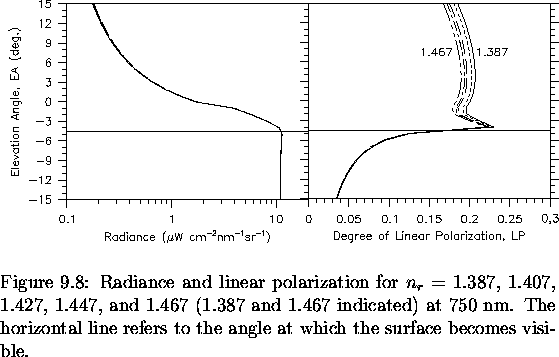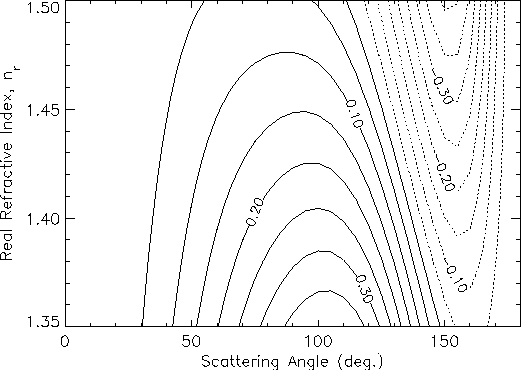
In an analysis similar to that of the previous section, comparisons will be made between aerosols of differing refractive indices while holding the optical depth constant.
Yue et al. (1994) have derived zonal averages of the sulphate
acid weight fraction, x, from Stratospheric Aerosol and Gas
Experiment (SAGE) II measurements. This was done using SAGE II
water vapour profiles and US National Meteorological Center temperature
profiles combined with a theoretical relationship for temperature,
water vapour partial pressure, and acid weight fraction (Russell and
Hamill, 1984). It was found that x varies from
0.58 near the tropopause to 0.86 near 35 km. The real component of the
refractive index at 750 nm will vary for these compositions from about
1.40 for x=0.58 to 1.44 at x=0.86 (Palmer and Williams, 1975).
The refractive index has also been measured from an in-situ instrument on
the ER-2 from 4-20 km. The Multiangle Aerosol Spectrometer Probe (MASP)
measured values in the stratosphere from 1.40-1.47 from a series of
flights in 1994 (Baumgardner et al., 1996). These measurements are
used to specify the range in refractive index for the sulphate aerosols.
The model was run for five
real components of refractive index: 1.387, 1.407, 1.427, 1.447, and
1.467 with
![]() and
and
![]() .
The results are shown in Figure 11. Clearly, there was minimal impact on
the radiances.
.
The results are shown in Figure 11. Clearly, there was minimal impact on
the radiances.
A change of 0.02 in refractive index resulted
in a change in polarization of <0.05.
Optimum geometry can again be assessed by examining
the single-scattering polarization. This is shown in Figure 5.12
as a function of refractive index from 1.36 to 1.50 at 750 nm.
Scattering angles from 70![]() -110
-110![]() and
145-165
and
145-165![]() appear to be the most sensitive.
appear to be the most sensitive.
The size of the glory peak, not evident in Figure 5.12 as the particles used for the calculation are not large enough, is also a function of refractive index. The glory peak decreases with decreasing refractive index through the range of refractive indices relevant to this study (van de Hulst, 1957).
 |
It would appear that refractive index is, in general, not a good candidate for retrieval as the uncertainty in the retrieved value will be roughly the same as the expected range possible for stratospheric sulphates.